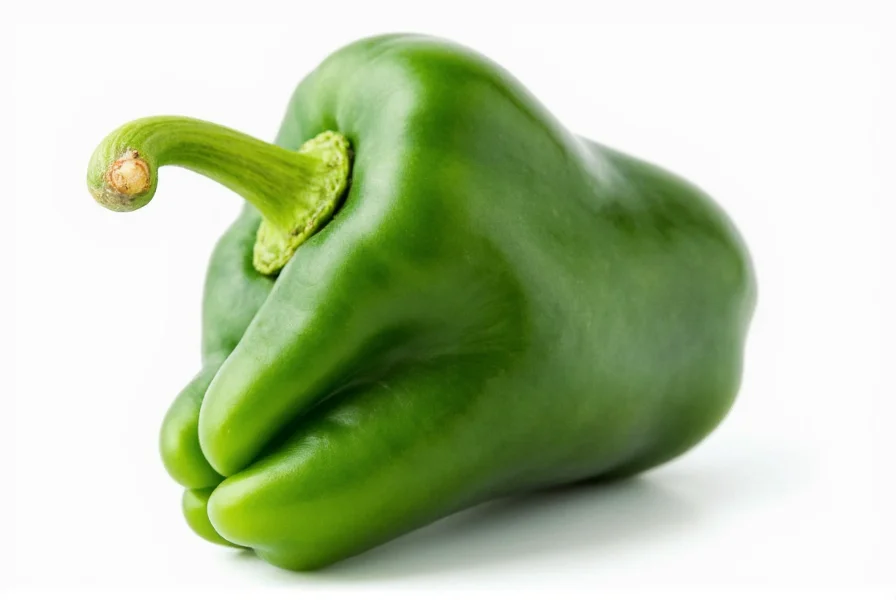Understanding what is a poblano pepper begins with recognizing its physical characteristics. These large peppers typically grow 4-6 inches long with a broad, heart-shaped body and thick walls. Immature poblanos display a deep forest green color, but they can ripen to vibrant red, brown, or even purple hues. Their smooth, glossy skin and substantial size make them easily distinguishable from slender hot peppers like cayennes.

Flavor Profile and Heat Level
When exploring what does a poblano pepper taste like, culinary experts describe a complex flavor profile that's earthy with subtle grassy notes and mild fruitiness. Unlike intensely hot peppers, poblanos deliver gentle warmth that builds gradually rather than overwhelming the palate. The how hot is a poblano pepper question finds its answer in the Scoville scale: 1,000-2,000 units, placing them milder than jalapeños (2,500-8,000) but hotter than bell peppers (0 units).
| Pepper Type | Scoville Heat Units | Flavor Characteristics |
|---|---|---|
| Poblano (fresh) | 1,000-2,000 | Earthy, mild fruitiness, grassy notes |
| Ancho (dried poblano) | 1,000-2,000 | Sweet, raisin-like, smoky complexity |
| Jalapeño | 2,500-8,000 | Sharp heat, bright grassy flavor |
| Bell Pepper | 0 | Sweet, crisp, no heat |
Origin and Culinary Significance
The poblano pepper name origin traces directly to Puebla, Mexico, where these peppers have been cultivated for centuries. Mexican chefs prize poblanos for their versatility in traditional dishes like chiles rellenos (stuffed peppers), mole sauces, and rajas con crema (sliced peppers in cream sauce). Unlike many chili varieties that deliver immediate heat, poblanos provide nuanced flavor that enhances rather than dominates dishes.
Fresh vs. Dried: Ancho Peppers Explained
One crucial aspect of what is a poblano pepper involves understanding its transformation when dried. Fresh poblanos become what dried poblano pepper is called – ancho peppers – which develop dramatically different flavor characteristics. The drying process concentrates sugars and creates complex notes of dried fruit, tobacco, and subtle smoke. Anchovies contribute essential depth to mole negro and other complex sauces where fresh poblanos wouldn't provide the same dimensional flavor.
Practical Kitchen Applications
When considering poblano pepper uses in cooking, their thick walls make them ideal for stuffing, while their moderate heat allows generous use without overwhelming other ingredients. Roasting fresh poblanos over open flame or under a broiler enhances their natural sweetness and creates a charred exterior that adds smoky complexity. After roasting, the skin peels away easily, revealing the tender flesh beneath.
For home cooks wondering what to substitute for poblano pepper, consider these alternatives based on your recipe's needs:
- For mild heat and similar size: Large bell peppers with a pinch of cayenne
- For closer flavor match: Anaheim peppers (slightly hotter)
- For stuffed pepper dishes: Cubanelle peppers
- For dried pepper applications: Mulato or pasilla peppers
Growing and Selection Tips
Gardeners interested in how to grow poblano peppers should note they require 65-80 days to maturity and prefer warm temperatures. When selecting fresh poblanos at the market, look for firm, glossy specimens without wrinkles or soft spots. Darker green peppers tend to be more bitter, while those with reddish undertones offer slightly sweeter flavor. Store fresh poblanos in the refrigerator's crisper drawer for up to two weeks.

Nutritional Benefits
Beyond flavor, poblano pepper nutrition facts reveal significant health benefits. Like all chili peppers, poblanos contain capsaicin (though in modest amounts) and are excellent sources of vitamins A and C. A single poblano provides approximately 120% of the daily recommended vitamin C intake and delivers notable amounts of vitamin B6, potassium, and dietary fiber. The antioxidants present in poblanos may help reduce inflammation and support cardiovascular health.
Storage and Preservation Methods
Understanding how to store fresh poblano peppers extends their kitchen usability. Keep unwashed peppers in a perforated plastic bag in your refrigerator's crisper drawer for optimal freshness. For longer preservation:
- Freezing: Roast, peel, and freeze in airtight containers for up to 6 months
- Drying: String and air-dry or use a food dehydrator to create anchos
- Pickling: Preserve in vinegar brine for tangy additions to dishes











 浙公网安备
33010002000092号
浙公网安备
33010002000092号 浙B2-20120091-4
浙B2-20120091-4